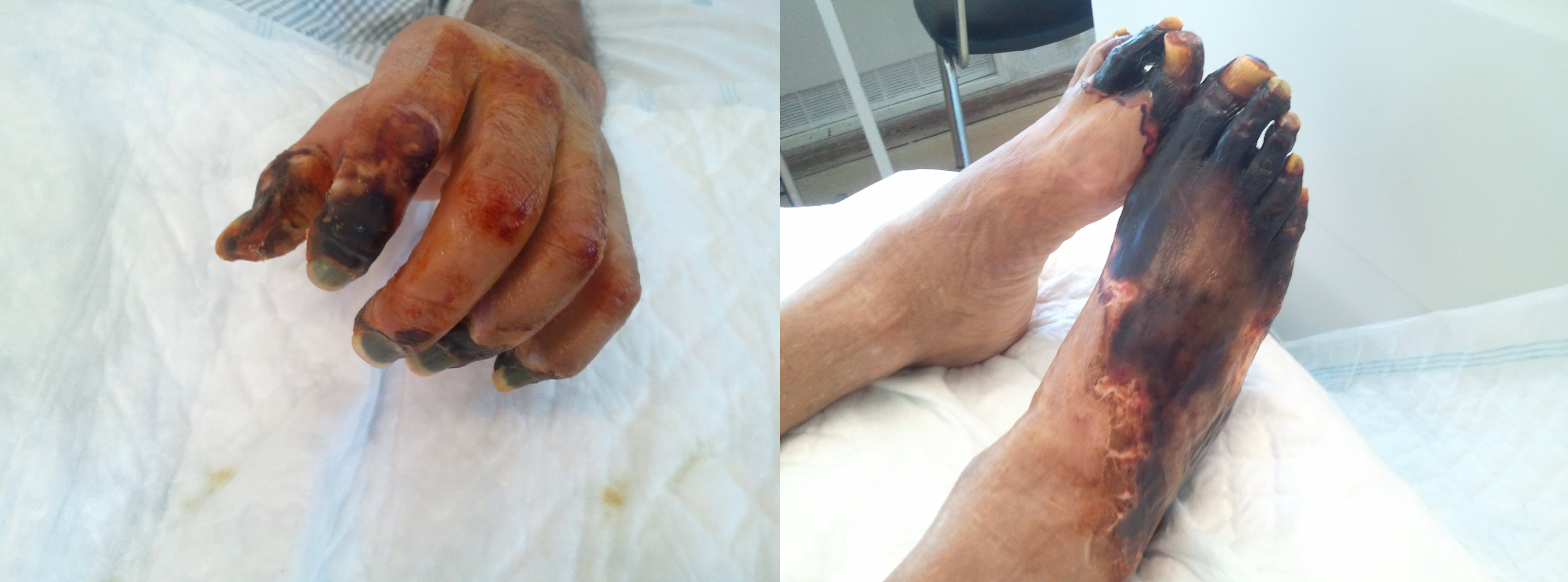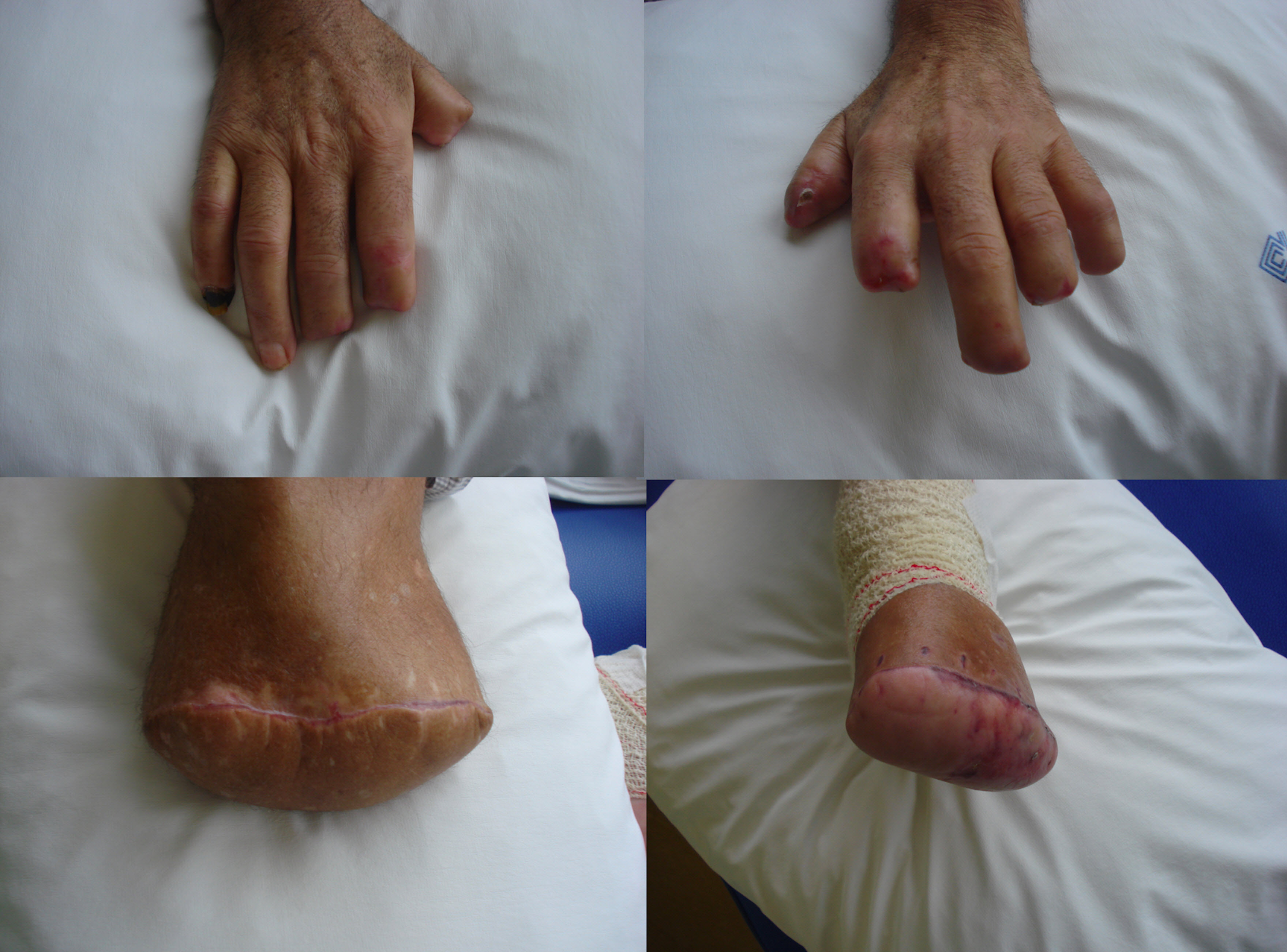Introduction
Autoimmune diseases are, often, diagnostic challenges. They may present in a wide spectre of clinical manifestations, from almost imperceptible to a severe and fulminant course, and, not rarely, one patient may fulfil diagnostic criteria of two different conditions. 1-3 The delay in the diagnosis, especially in more severe cases, may increase the morbimortality.
The authors report a case of a diffuse systemic sclerosis and secondary antiphospholipid syndrome with severe manifestations and fatal outcome.
Clinical Case
A sixty-three-year-old male was admitted to the hospital with respiratory failure due to community-acquired pneumonia.
Two months earlier, he had been diagnosed with diffuse systemic sclerosis and secondary Sjögren syndrome. He presented with xerostomia, xerophthalmia, Raynaud phenomenon, dyspnea and gastroesophageal reflux symptoms one year before hospitalization. Significant findings on physical exam included skin thickening proximal to the metacarpal and metatarsophalangeal joints and upper trunk (Rodnan skin score: 36), “puffy fingers” and sclerodactyly. Immunologic workup revealed ANA 1/80 speckled pattern (normal <1/80) and Anti SS-A (Ro) antibody: 67,90 U/mL (normal: 0-15). Salivary gland scintigraphy reported moderate dysfunction of the parotid glands. Upper gastrointestinal endoscopy showed reflux esophagitis and erosive gastropathy. High resolution computed tomography scan and pulmonary biopsy were compatible with usual interstitial pneumonia.
In the first days of hospitalization he was not improving, despite adequate antibiotic coverage.
On the 6th day, he complained of blurred vision and began topic treatment for a vitritis, after an ophthalmology consult. Next day, he presented with reversible cyanosis of all fingers of the right foot. He was observed by a vascular surgeon and started anticoagulation with low molecular weight heparin. Two days later, he developed severe cardiorespiratory distress, requiring mechanical ventilation for 10 days.
On admission to the intensive care unit, transthoracic echocardiography displayed signs of acute heart failure with severe depression of left ventricular systolic function, compatible with stress cardiomyopathy. Pulmonary thromboembolism was excluded by thoracic angio-computed tomography.
He evolved with necrosis of the distal phalanges of all fingers except the 4th finger of the right hand (fig. 1) and bilateral amaurosis with ocular alterations compatible with acute retinal ischemia.
He was treated with iloprost perfusion for 10 days and non-fractionated heparin for 7 days, then changed to low molecular weight heparin 1 mg/Kg every 12 hours. Acetylsalicylic acid, pentoxifylline, calcium channels blocker and angiotensin converting enzyme inhibitor were also prescribed.
Clinical progress was favourable. He still experienced several episodes of acute pulmonary edema with good response to endovenous nitrates. Coronary catheterism, performed while on anticoagulant therapy for several days, excluded ischemic etiology and transthoracic echocardiography revealed improvement in the systolic function of the left ventricle.
When stabilized, an amputation of distal phalanges of the left hand, first to third fingers of the right hand, transmetatarsic in the left foot and below the right knee was performed (fig. 2). The visual acuity was partially recovered.
The workup, before anticoagulation treatment, showed ANA 1/80 speckled pattern, anticardiolipin antibody: 116 MPL-U/mL (positive if > 40), anti-β2 glycoprotein antibodies: 76 U/mL (positive if > 10) and lupus anticoagulant with antiphospholipid characteristics. Similar results were obtained more than 12 weeks later, under low molecular weight heparin.
Other intercurrences during hospitalization included: Pseudomonas aeruginosa cystitis; dysphagia that conditioned incapability for oral alimentation till the sixtieth day of hospitalization, with videofluoroscopy revealing oesophageal abnormalities compatible with systemic sclerosis; myopathy and cachexia with slow but good response to physiotherapy.
The patient was discharged to a rehabilitation unit. after 94 days of hospitalization, on oral anticoagulation with warfarin for targeted INR levels between 2 and 3 and aspirin 100 mg/day.
After 6 months, he had complete healing of the stumps and was responding well to intensive physiotherapy. Nevertheless, and despite having INR values were within therapeutic range, he suffered a spontaneous extensive bleeding in the brain stem that led him to die.
Discussion
This case illustrates severe ischemic complications of an autoimmune phenomenon.
Before the admission, the patient was already diagnosed with diffuse systemic sclerosis and secondary Sjögren syndrome, but no previous thrombotic events were documented.
Once hospitalized, ischemic manifestations began, with retinal and digital involvement and severe Raynaud’s phenomenon. Coronary catheterism excluded ischemic disease and the acute heart insufficiency was interpreted as stress cardiomyopathy. Thoracic angio-computed tomography allowed to rule out pulmonary thromboembolism.
The final diagnosis was not readly understood and it was thought that the ischemic complications could be due to severe vasospasm from systemic sclerosis. However, the clinical presentation and the autoimmune study led to accept, as the most probable diagnosis, the antiphospholipid syndrome, and so, the ischemia would be caused, mostly, by thrombotic events. Strictly, it lacks histologic confirmation of the presence of thrombi to fully support the diagnosis.4 Also, antiphospholipid antibodies are associated with other conditions, as systemic sclerosis or systemic erythematous lupus. 5,6 But, in this case, the overall presentation, evolution and immunologic workup were much consistent with antiphospholipid syndrome.
The diagnosis of systemic sclerosis and secondary antiphospholipid syndrome is not a common one, but there are some reports in literature of this association.7-9
We would like to emphasize the severe manifestations of this case, with a very rapid development and challenging management. Though early therapeutic actions, amputation nor decrease of visual acuity couldn’t be avoid. Because there were only two organs affected by ischemia (fingers and eyes) this can´t be called a catastrophic antiphospholipid syndrome, despite the similar course. 10-13
Management of the ischemic complications was complex. The probable causes were thrombotic or vasospasm. Treatment was intended to prevent thrombosis, the inflammatory reaction and the hypercoagulable state and vasospasm.12-14 Anticoagulation, vasodilators and antiplatelet agents were used. It was decided to keep INR between 2-3 and add aspirin 100mg/day among other non-trombotic therapy. 13-15
Conclusion
Autoimmune diseases are, sometimes, hard to classify, especially when criteria of more than one condition is present. The manifestations may be subtle or life-threatening. Additionally, it is not rare to encounter secondary pathologies or overlap syndromes, and often the immunologic evaluation is crucial to a correct diagnosis. The delay in the identification may compromise the quality of life.
In this case, serious ischemic complications affected the autonomy of the patient. The first interpretation was to attribute it to the known disease, but it didn’t fully explain the whole scenario.
With this report the authors intend to emphasize two main things: how severe manifestation of autoimmune diseases can be and how complex its diagnosis and management can get.
Figura I

Figure 1: Severe ischemic complications of systemic sclerosis and antiphospholipid syndrome. The probable causes were thrombotic or vasospasm. Left: left hand, Right: Feet.
Figura II

Figure 2: Post amputation of distal phalanges of the left hand (top right), 1st to 3rd fingers of the right hand (top left), transmetatarsic in the left foot (bottom right) and below the right knee (bottom left).
BIBLIOGRAFIA
References
1 Panush RS, Kramer N, Rosenstein ED. Undifferentiated systemic rheumatic (connective tissue) diseases and overlap syndromes. In UpToDate, 2016, Jan. http://www.uptodate.com/contents/undifferentiated-systemic-rheumatic-connective-tissue-diseases-and-overlap-syndromes (accessed 1 Oct 2016).
2 Iaccarino L, Gatto M, Bettio S, Caso F, Rampudda M, Zen M et al. Overlap connective tissue disease syndromes. Autoimmun Rev 2013;12(3):363-73.
3 Pepmueller PH. Undifferentiated Connective Tissue Disease, Mixed Connective Tissue Disease, and Overlap Syndromes in Rheumatology. Mo Med 2016;113(2):136-40.
4 Keeling D, Mackie I, Moore GW, Greer IA, Greaves M and British Committee for Standards in Haematology. Guidelines on the investigation and management of antiphospholipid syndrome. Br J Haematol 2012;157(1):47-58.
5 Sanna G, Bertolaccini ML, Mameli A, Hughes GRV, Khamashta MA, Mathieu A. Antiphospholipid antibodies in patients with scleroderma: prevalence and clinical significance. Ann Rheum Dis 2005;64:1795–96.
6 Austin S, Cohen H. Antiphospholipid syndrome. Medicine 2006;34(11):472–475.
7 Minatani M, Takasaki J, Iwata H, Kinoshita M, Aotsuka S, Sumiya M. Acute interstitial pneumonia associated with antiphospholipid syndrome in a patient with systemic sclerosis. Clin Exp Rheumatol 2000;18:786.
8 Zandman-Goddard G, Tweezer-Zaks N, Shalev T, Levy Y, Ehrenfeld M, Langevitz P. A Novel Overlap Syndrome: Systemic Sclerosis Associated with Antiphospholipid Syndrome—a Case Series. Ann N Y Acad Sci 2007;1108:497-504.
9 Leite Pd, de Carvalho JF. Systemic sclerosis sine scleroderma associated with antiphospholipid syndrome. Rheumatol Int 2012; 32:3265–68.
10 Westney GE, Harris EN. Catastrophic antiphospholipid syndrome in the intensive care unit. Crit Care Clin 2002 Oct;18(4):805-17.
11 Asherson RA. The catastrophic antiphospholipid (Asherson´s) syndrome. Autoimmun Rev 2006;6(2):64-7.
12 Khamashta MA. Hughes Syndrome: Antiphospholipid Syndrome. Springer London 2006:171-80.
13 Lim W. Antiphospholipid Syndrome. Hematology Am Soc Hematol Educ Program 2013;2013:675-80.
14 Schur PH, Kaplan AA. Treatment of the antiphospholipid syndrome. In UpToDate 2016, Aug. http://www.uptodate.com/contents/treatment-of-antiphospholipid-syndrome (accessed 1 Oct 2016).
15 Ruiz-Irastorza G, Cuadrado MJ, Ruiz-Arruza I, Brey R, Crowther M, Derksen R et al. Evidence-based recommendations for the prevention and long-term management of thrombosis in antiphospholipid antibody-positive patients: Report of a Task Force at the 13th International Congress on Antiphospholipid Antibodies. Lupus 2011;20(2):206-18.



